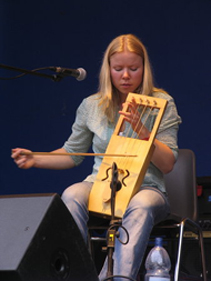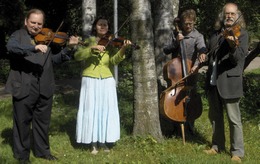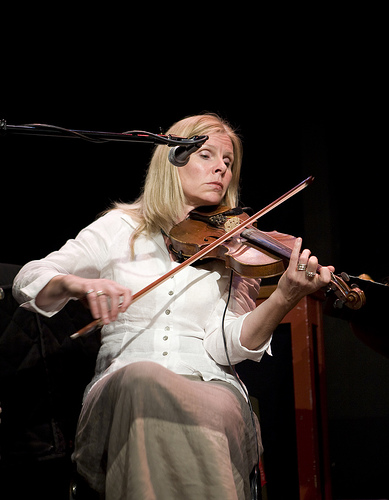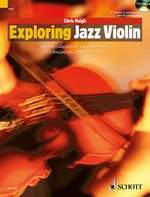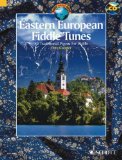
MENU TO FIDDLE STYLES:
............................
Baltic Fiddle
Facing onto the chilly Baltic sea, the Baltic states of Latvia, Lithuania and Estonia lie at a northern crossroads nestled between Scandinavia to the north and west, Russia and the Slavic states to the east, and western Europe to the south and west. As small countries surrounded by large and often menacing neighbours they have spent many centuries under foreign rule, only briefly achieving independence after the first World war, only to be swallowed up again by the Soviet Empire in 1939. In all three countries the fiddle plays an important part in folk music, which itself played an important role in maintaining national solidarity in the difficult years up to the end of occupation in 1988.
ESTONIAN FIDDLE
Fiddle playing has a long and varied history in Estonia, with numerous different fiddle variants in use at different times. As in most musical cultures, the bowed fiddle was preceded by a selection of harps, zithers and lyres. These three terms refer broadly to three groups of instruments, but they are often and easily confused. From a fiddler’s point of view the important thing is that they are all plucked In the Baltics the oldest and best-established instrument was the kannel- a type of zither, which dates back around 2,000 years.
The Kannel
The bow arrived around the 12thC, somewhat later than in southern Europe, and soon there was a bowed kannel, the hiiu kannel, introduced by Swedes who settled the coastal areas and islands of Estonia in the 13th and 14thC. Whilst the kannel had been a flat, rectangular or trapezoid instrument with around 7 strings, the bowed version had a narrower body, soon resembling the modern fiddle in outline, with the number of strings reducing to 3 or 4. The strings are of gut or horsehair.Typical of primitive fiddles, it was played on the knee like a lyra, gadulka or Kemence. The Swedish version is called the Strackharpa or Talharpa, whilst in Finland it is called the Jouhikko.
Sille playing the Kannel The violin proper did not reach Estonia till the 17thC; by the 18thC it was established as a “folk” instrument among the rural communities. Whilst bagpipes had been the pre-eminent instrument for dancing, with the arrival of more modern dance forms in the 19thC (Mazurka, Walzt and Polka) the violin, far more suitable for these types of tune, began to dominate. A newspaper in Latvia, the Latviesu avizes, said in 1865 “Nowadays they dance to violins, in those early days, to bagpipes”. For some time the two coexisted, allowing the fiddle to take on board some of the repertoire and playing style of the pipes, perhaps contributing to the frequent use of drones in Estonian fiddle playing. Until the middle of the 19thC the fiddle was usually played solo, and the fiddler would have been a respected figure and much in demand at weddings. Towards the end of the century larger ensembles became popular, the fiddler sharing the stage with concertina, accordion, dulcimer, guitar, bass or drums. Two violins were often heard together as the core of maybe a four-piece band.
The Moldpill
A curious fiddle dating from the early 19thC is the Moldpill or Psalmodikon. With its boat or trough-like body and single string, this is often mistaken for an ancient instrument, but was in fact a recent development designed for ease of construction and learning. It was used in Lutheran church music for the accompaniment of psalm singing.The Bladder Fiddle
Another curiosity is the Bladder Fiddle (poispil or bumbass) A little like the musical bow found in parts of Africa, this is an arched stick 1 to 1.5 metres in length with a single string tied at both ends. At the lower end a pigs bladder filled with air acts as a resonator. The string is sounded with a horsehair bow, and the pitch can be changed by pressing down on the string. It has little use as a melody instrument, but can be useful for providing a drone and rhythm accompaniment, fulfilling a similar role to the jew’s harp. It often appears as a novelty or joke instrument during wedding celebrations.Contemporary Estonian Fiddling
One of the leading players today, both on the fiddle and kannel, is Sille; she studied at the Viljandi Cultural Academy but since 2003 has been resident in Wales, where she performs in collaboration with many of the top Welsh folk musicians including fiddling brothers the Kilbrides, and fiddle and crwth players Ceri Rhys Matthews and Cass Meurig. She also has a duo with Martin Leamon called Sild. She describes her Kannel as a "bowed harp". It has four horsehair strings, usually tuned DDEA (from low to high), an octave down from violin tuning. She also uses EEAE, ADAE and AEAE. The top two strings are used for melody, the lower two for drones.Another influential Estonian fiddle player today is Johanna-Adele Jüssi. In an interview in "Fiddler Magazine", she described the essence of Estonian fiddle as ...
"danceability; there is very little, if any, lyricism. The fiddle tunes are usually quite simple in their basic form and are repeated over and over again, varying the melody. There are hardly any minor tunes in the Estonian fiddle repertoire. Maybe this is the biggest difference from Nordic, Finnish and Celtic traditional music"
Johanna-Adele Jüssi
LITHUANIAN FIDDLE
In Lithuania the fiddle is known as the Griezyne. Lying west of Russia and Belarus and north of Poland, Lithuania was an independent state until it was annexed by the Soviet Union at the outbreak of WW2. During the years of occupation, until independence was regained in 1991, folk music was something of a symbol of resistance against Soviet dominance.The kankles is the Lithuanian equivalent of the Latvian Kannel; an archaic zither. Up until the mid 19thC the kankles dominated dance ensembles, with up to three of them in a band, alongside fiddle and a drum. In the second half of the century a new repertoire of “modern” European dances- waltzes, polkas, schottiches, marches and krakowiaks became established, and the fiddle increasingly became the lead instrument, accompanied by harmonica, string bass, and wind such as clarinet and coronet.
Early recordings from the 1930’s, now available on re-release, show that this repertoire and type of ensemble was still in common use.
Fiddle playing was woven tightly into the fabric of Lithuanian folklore and custom. It was an essential part of each part of the wedding ceremony, and attached to many seasonal celebrations. The fiddle also took on some aspects of pre-christian belief and ritual. In a detailed study of fiddle playing in Lithuanian society, Algirdas Clova found that:
The fiddling was closely related to the Lithuanian folk customs based on mythic and religious view of the world. The fiddler can be viewed as a person adopting and saving relics of the role of pre-Christian prophet, witch or wizard. The fiddle, fiddler and fiddling played a role of mediator between this world and the beyond, death and life, lower and upper spheres of the world……Although the fiddle is usually associated with mythic creatures of the earth and under-earth, with the world of the dead, devil and magic, and the connections between the fiddle and heaven-deities are also reported.
Contemporary Lithuanian Fiddling
One of the leading players today is Algirdas Klova, a fiddler who has a strong interest both in traditional Lithuanian music (particularly the sutartines tradition of Aukstaitja, and in American fiddle styles such as countryand Texas swing. He helped to found the Griezyne international festival of International Folk, a biennial gathering held in the capital Vilnius, and considered “The most enduring in the Eastern Baltics”.
Algirdas Klova (left) with the Lithuanian fiddle band Vilniaus Griezyne Among the most successful regular performers at the festival are the group Griezikai, who launched in 1997, all graduates of Ethnomusicology and Performance at the Lithuanian Academy of Music. The line-up includes 3 violins and a bandoneon.
LATVIAN FIDDLE
Latvia is the middle of the Baltic states, sandwiched between Estonia (to the north) and Lithuania (to the south). Folk music has played a big part in its culture and history, particularly singing; during the years of Soviet occupation, folksong was seen as a symbol of national pride and resistance. As the Soviet empire began to crumble in the late 80’s Romanians took to the streets with rifles to battle the securitate. Latvians on the other hand chose folksong as their weapon. In 1988 300,000 of them gathered to sing in Tallinn Square, instigating the “Singing Revolution” which ultimately led to the departure of the Soviets.Among the best-known Latvian folk bands is Ilgi, started by violinist and music graduate Ilga Reizniece in 1981. They started out with a strong ethno-musicalogical bias, seeking authenticity in every aspect of the performance, including instruments, repertoire, traditional costumes and so on. To the Soviet regime this spelled nationalism and was considered as dangerous as rock music and for a time all mention of the group was banned in Latvian publications. Since the end of communism they have expanded in repertoire and outlook, now including electric instruments and a rock feel to much of their work.
Latvian fiddler Ilga Reizniece One of the most interesting aspects of fiddling in Latvia is the use of the giga or trough fiddle, a large rectangular box-like instrument played like a cello with one or two strings. Due to the shape of the body it is sometimes referred to as a trough-fiddle. In Ilgi, the giga is played by Gatis Gaujenieks.
Indianapolis-based band the Hedgehogs also use the giga, alongside other Latvian and baltic instruments such as the kokle (a type of zither, and perhaps the best-known Latvian folk instrument), the bagpipe and the Novgorod lyre.
Return to fiddlingaround.co.uk homepage
Chris Haigh is a freelance fiddle player based in London. .
Eastern European Fiddle Tunes-80 Traditional Pieces for Violin BK/CD (Schott World Music Series)
Pete Cooper hooks us right from the start, with a folk tale of gypsies, fiddles, and the devil. Fiddling in eastern Europe is more than just a bit of light entertainment; it’s the stuff of history, magic and legend. Cooper immediately banishes the idea that there is a single east European style; it ranges from the virtuosic semi –classical gypsy fiddling to relatively basic and rootsy folk playing. For those nervous of venturing much beyond first position, you’ll be pleased to hear that this book is geared more towards the latter than the former end of the spectrum. MORE...
